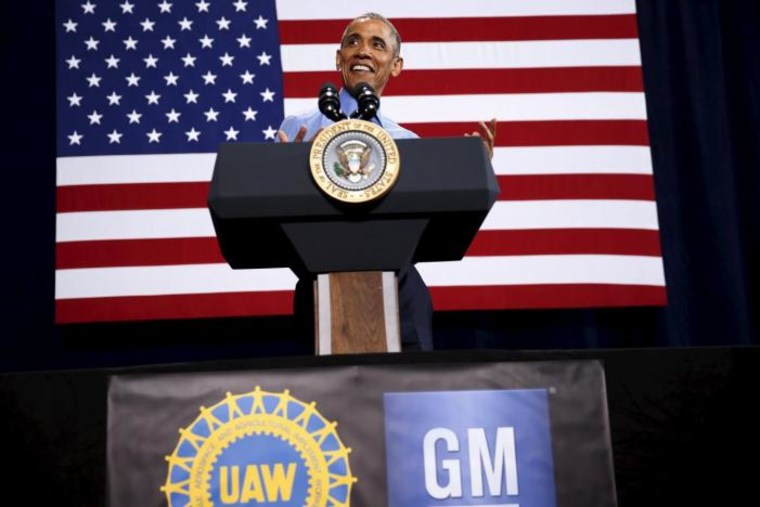As the new Trump administration takes shape, auto industry leaders will watch to see how it handles issues ranging from fuel economy regulations to tariffs and trade — and compare that to what happened during the eight years when President Barack Obama was in the driver’s seat.
Few presidents have been in power during a time of such massive change for this powerhouse industry. When Obama entered the White House in January 2009, all three domestic automakers seemed ready to fail — two soon filing for bankruptcy. Today, the industry is, on the whole, turning record profits.
Related: Why the Next President Will Face an Automotive Revolution
Obama’s tenure coincided with massive transformation in an industry where change is expected to continue playing out over the years and decades to come, especially with the emergence of autonomous vehicles and the rise of ride- and car-sharing.
The outgoing president attempted to reach out to industry leaders; in his 2014 State of the Union address he hailed the factory-floor-to-CEO rise of General Motors CEO Mary Barra as illustrating “the strength of our work ethic and the scope of our dreams.”
The Big Bailout
In turn, Obama garnered praise from industry leaders. Asked to comment upon his legacy, Ford told NBC News that Obama’s decision to provide a multi-billion-dollar bailout of rivals GM and Chrysler “was the right thing to do for the country.”
The bailout was Obama’s first big test, requiring him to expand upon the steps taken by predecessor George W. Bush. The new president justified the move, declaring it would save 1 million American jobs and keep the recession from becoming a depression.
Nonetheless, it remains one of the biggest controversies of Obama’s eight years in office, though there were others involving the auto industry:
- A loan program to develop high-efficiency vehicles and technology was scrapped after several high-profile failures, including the collapse of Fisker Automotive
- A program aimed at scrapping old, polluting vehicles and boost sales of domestic autos achieved marginal success — and largely boosted demand for imports
- Sales of plug-based vehicles, such as the Chevrolet Volt extended-range electric, fell far short of the president’s goal of 500,000.
That said, many industry analysts believe battery-cars reached critical mass, with the launch of lower-priced, higher-mileage models such as the Chevrolet Bolt EV.
And development of autonomous vehicles, a prime goal of the Department of Transportation, has hit “an inflection point,” as well, said John Krafcik, CEO of Waymo, the recently renamed Google self-driving car subsidiary.
The Rise of Autonomous Driving
Retail sales are still a few years away, but Mark Rosekind, outgoing administrator of the National Highway Traffic Safety Administration, now foresees an era of “zero deaths on American highways.”
Rosekind, who joined the administration halfway through its second term, has been widely hailed by industry leaders such as Joe Hinrichs, the President of the Americas at Ford, as being the most “cooperative” automotive regulator in decades. That was underscored by the January 2016 formation of an industry-government consortium aimed at bringing breakthrough safety technology to market faster than possible through the regulatory process.
But Rosekind and the rest of the administration matched carrots with sticks. In just the last few weeks, Volkswagen, GM, and supplier Takata have all faced hefty fines — while six VW employees and three from the Japanese supplier were indicted.
The emergence of ride-sharing will be another Obama era legacy, and many question whether that could even more rapidly reshape the auto industry — especially if driverless vehicles ultimately make it cheaper to hail a ride than own a car.
What Does Trump Inherit?
For now, automakers can celebrate three consecutive years of record sales, last year reaching 17.4 million. Trump may not be as lucky, as sales are expected to dip in 2017 for the first time since the Great Recession.
The Trump campaign focused on manufacturing jobs, threatening companies like Ford, GM, and Toyota with hefty new import tariffs. A recent flurry of job announcements actually caps a strong legacy from Obama. Since 2010, the Detroit makers alone have saved or added nearly 40,000 jobs. Foreign-owned companies like Toyota, Nissan, and Daimler AG have invested a total of over $20 billion in the U.S. Volvo is readying its first assembly plant near Charleston. And BMW last year exported over half the output of its South Carolina plant.
Analyst Dave Sullivan, of AutoPacific, Inc. gives Obama generally solid marks, though he sees a few missed opportunities. Automakers need a national energy policy to guide planning. And the administration failed to work out a plan with Europe and other key markets to commonize lighting, emissions and safety standards, simplifying design and manufacturing.
Related: Regulators Asked to Ease Federal Fuel Economy Standards
Meanwhile, a key move by the Obama administration is seen by environmentalists as a victory, but is a major setback for automakers. Expect to see the debate over the 54.5 mpg corporate average fuel economy standard carried on under the new president.
“The only place we could go was up,” after the recession, said analyst Sullivan. But even with a few fumbles and missed passes, “I think we’ll look at this as a good time for the auto industry,” he said.
